HA3032 Auditing and Assurance: Audit Report of Schrole Group Ltd
VerifiedAdded on 2023/06/07
|19
|4281
|241
Report
AI Summary
This report provides a comprehensive analysis of Schrole Group Ltd, a software and services company listed on the Australian Stock Exchange, focusing on its financial performance, audit, and assurance aspects. It delves into the company's nature and industry, utilizing an audit risk model to assess inherent, control, and detection risks. Analytical procedures, including ratio analysis (liquidity, activity, profitability, and solvency), are performed to evaluate the company's financial health and efficiency. The report also addresses planning materiality, setting a materiality level based on stable operating expenses, and identifies material account balances for both assets and liabilities, outlining audit procedures for verification. Furthermore, a sampling plan is discussed to ensure effective audit coverage. The analysis reveals trends in the company's financial indicators, including liquidity, profitability, efficiency, and solvency ratios, providing insights into its financial standing and potential risks. The document is intended to give a detailed overview of the audit process and financial assessment of Schrole Group Ltd.
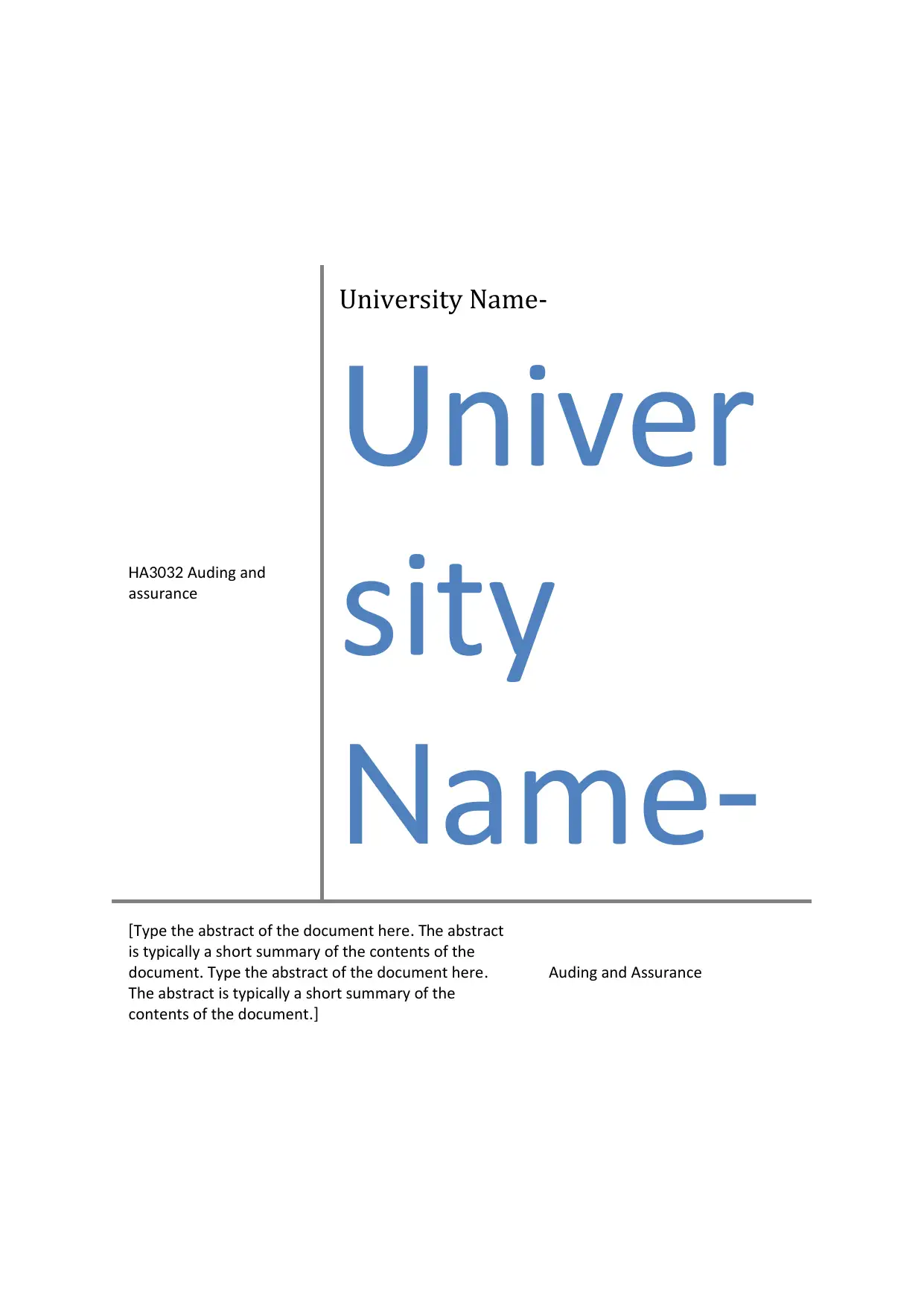
A Auditing andH 3032
assurance
University Name-
Univer
sity
ameN -
ype the abstract of the document here he abstract[T . T
is typically a short summary of the contents of the
document ype the abstract of the document here. T .
he abstract is typically a short summary of theT
contents of the document.]
Auditing and Assurance
assurance
University Name-
Univer
sity
ameN -
ype the abstract of the document here he abstract[T . T
is typically a short summary of the contents of the
document ype the abstract of the document here. T .
he abstract is typically a short summary of theT
contents of the document.]
Auditing and Assurance
Paraphrase This Document
Need a fresh take? Get an instant paraphrase of this document with our AI Paraphraser
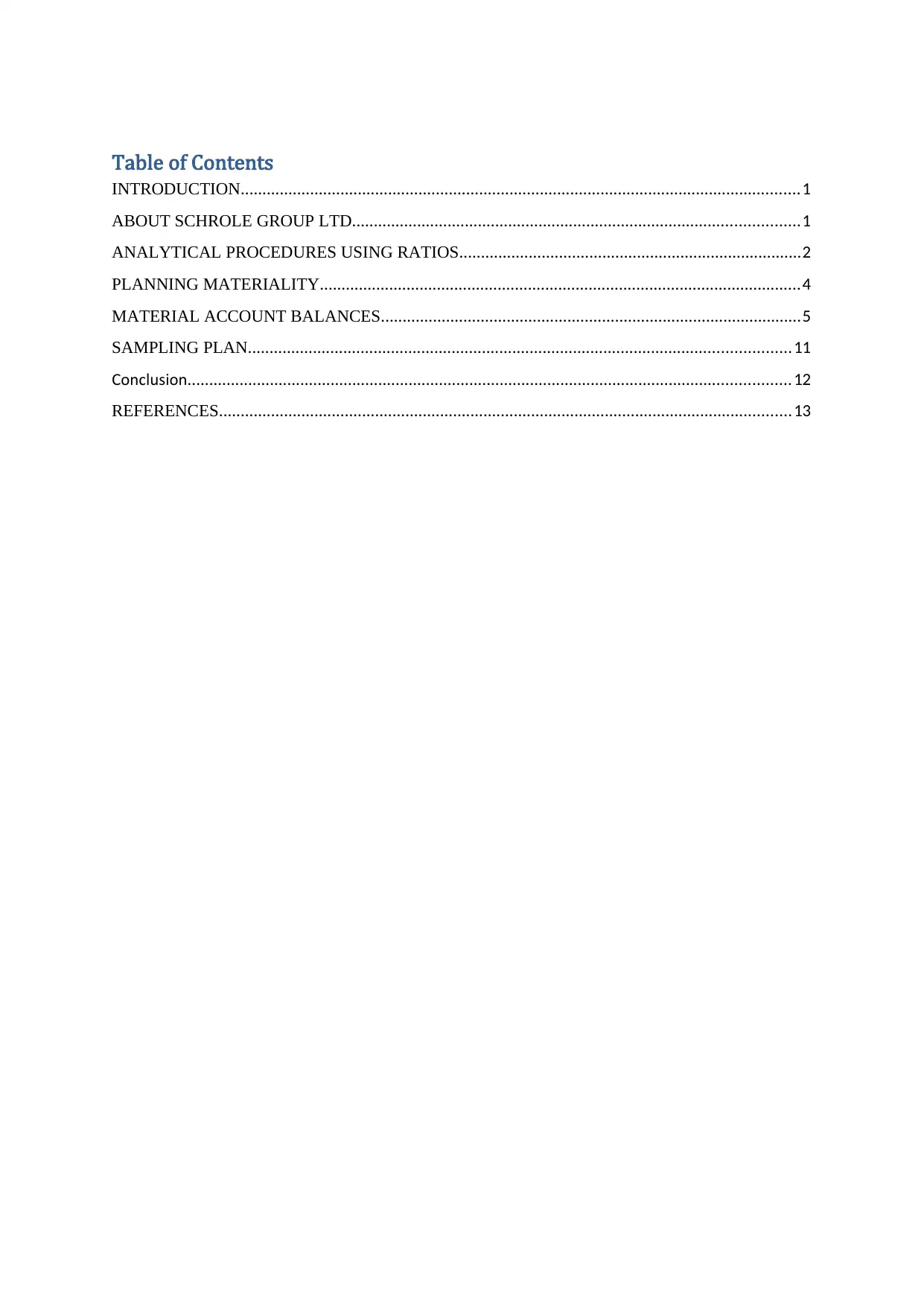
Table of Contents
INTRODUCTION.................................................................................................................................1
ABOUT SCHROLE GROUP LTD.......................................................................................................1
ANALYTICAL PROCEDURES USING RATIOS...............................................................................2
PLANNING MATERIALITY...............................................................................................................4
MATERIAL ACCOUNT BALANCES.................................................................................................5
SAMPLING PLAN.............................................................................................................................11
Conclusion...........................................................................................................................................12
REFERENCES....................................................................................................................................13
INTRODUCTION.................................................................................................................................1
ABOUT SCHROLE GROUP LTD.......................................................................................................1
ANALYTICAL PROCEDURES USING RATIOS...............................................................................2
PLANNING MATERIALITY...............................................................................................................4
MATERIAL ACCOUNT BALANCES.................................................................................................5
SAMPLING PLAN.............................................................................................................................11
Conclusion...........................................................................................................................................12
REFERENCES....................................................................................................................................13
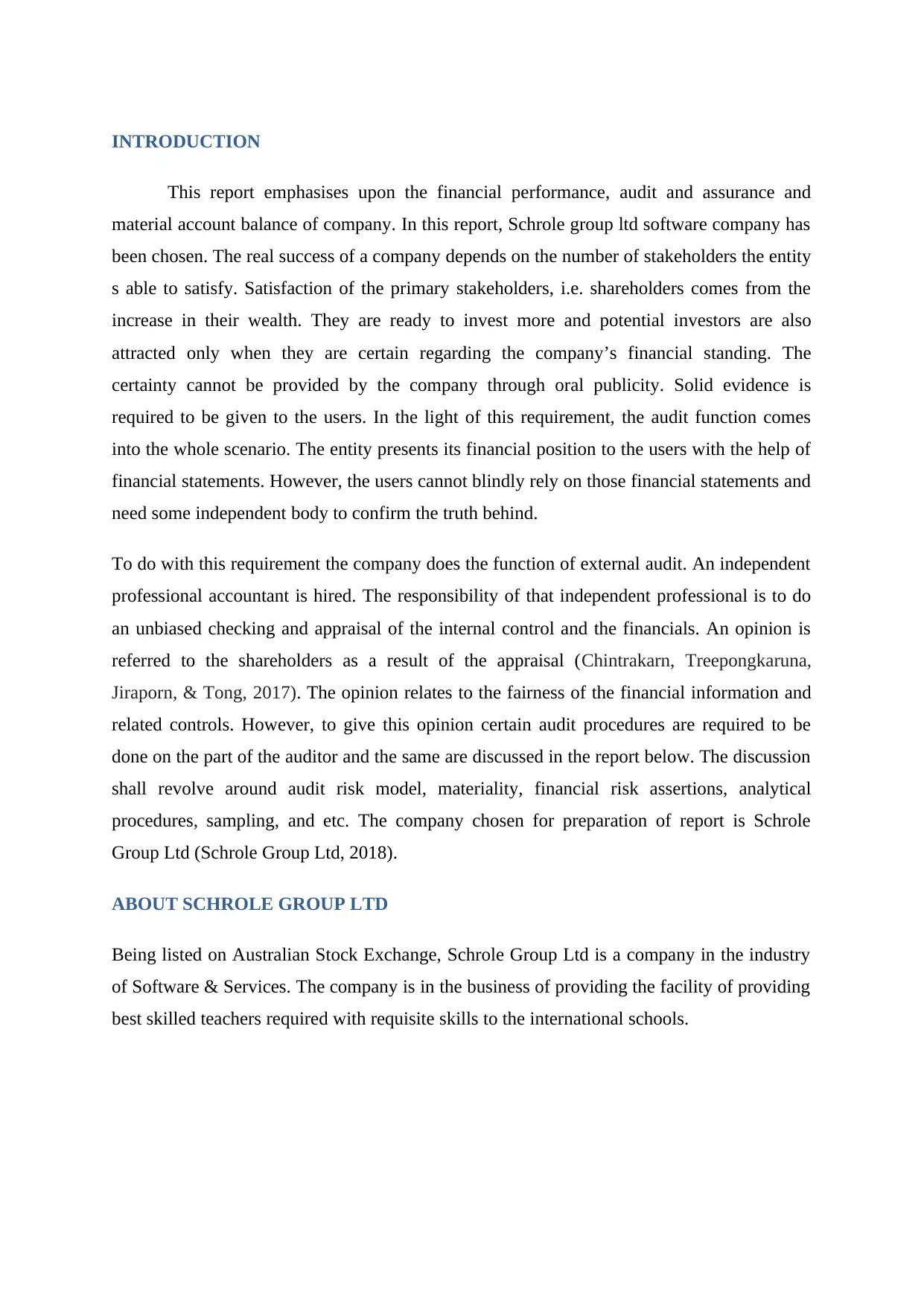
INTRODUCTION
This report emphasises upon the financial performance, audit and assurance and
material account balance of company. In this report, Schrole group ltd software company has
been chosen. The real success of a company depends on the number of stakeholders the entity
s able to satisfy. Satisfaction of the primary stakeholders, i.e. shareholders comes from the
increase in their wealth. They are ready to invest more and potential investors are also
attracted only when they are certain regarding the company’s financial standing. The
certainty cannot be provided by the company through oral publicity. Solid evidence is
required to be given to the users. In the light of this requirement, the audit function comes
into the whole scenario. The entity presents its financial position to the users with the help of
financial statements. However, the users cannot blindly rely on those financial statements and
need some independent body to confirm the truth behind.
To do with this requirement the company does the function of external audit. An independent
professional accountant is hired. The responsibility of that independent professional is to do
an unbiased checking and appraisal of the internal control and the financials. An opinion is
referred to the shareholders as a result of the appraisal (Chintrakarn, Treepongkaruna,
Jiraporn, & Tong, 2017). The opinion relates to the fairness of the financial information and
related controls. However, to give this opinion certain audit procedures are required to be
done on the part of the auditor and the same are discussed in the report below. The discussion
shall revolve around audit risk model, materiality, financial risk assertions, analytical
procedures, sampling, and etc. The company chosen for preparation of report is Schrole
Group Ltd (Schrole Group Ltd, 2018).
ABOUT SCHROLE GROUP LTD
Being listed on Australian Stock Exchange, Schrole Group Ltd is a company in the industry
of Software & Services. The company is in the business of providing the facility of providing
best skilled teachers required with requisite skills to the international schools.
This report emphasises upon the financial performance, audit and assurance and
material account balance of company. In this report, Schrole group ltd software company has
been chosen. The real success of a company depends on the number of stakeholders the entity
s able to satisfy. Satisfaction of the primary stakeholders, i.e. shareholders comes from the
increase in their wealth. They are ready to invest more and potential investors are also
attracted only when they are certain regarding the company’s financial standing. The
certainty cannot be provided by the company through oral publicity. Solid evidence is
required to be given to the users. In the light of this requirement, the audit function comes
into the whole scenario. The entity presents its financial position to the users with the help of
financial statements. However, the users cannot blindly rely on those financial statements and
need some independent body to confirm the truth behind.
To do with this requirement the company does the function of external audit. An independent
professional accountant is hired. The responsibility of that independent professional is to do
an unbiased checking and appraisal of the internal control and the financials. An opinion is
referred to the shareholders as a result of the appraisal (Chintrakarn, Treepongkaruna,
Jiraporn, & Tong, 2017). The opinion relates to the fairness of the financial information and
related controls. However, to give this opinion certain audit procedures are required to be
done on the part of the auditor and the same are discussed in the report below. The discussion
shall revolve around audit risk model, materiality, financial risk assertions, analytical
procedures, sampling, and etc. The company chosen for preparation of report is Schrole
Group Ltd (Schrole Group Ltd, 2018).
ABOUT SCHROLE GROUP LTD
Being listed on Australian Stock Exchange, Schrole Group Ltd is a company in the industry
of Software & Services. The company is in the business of providing the facility of providing
best skilled teachers required with requisite skills to the international schools.
⊘ This is a preview!⊘
Do you want full access?
Subscribe today to unlock all pages.

Trusted by 1+ million students worldwide
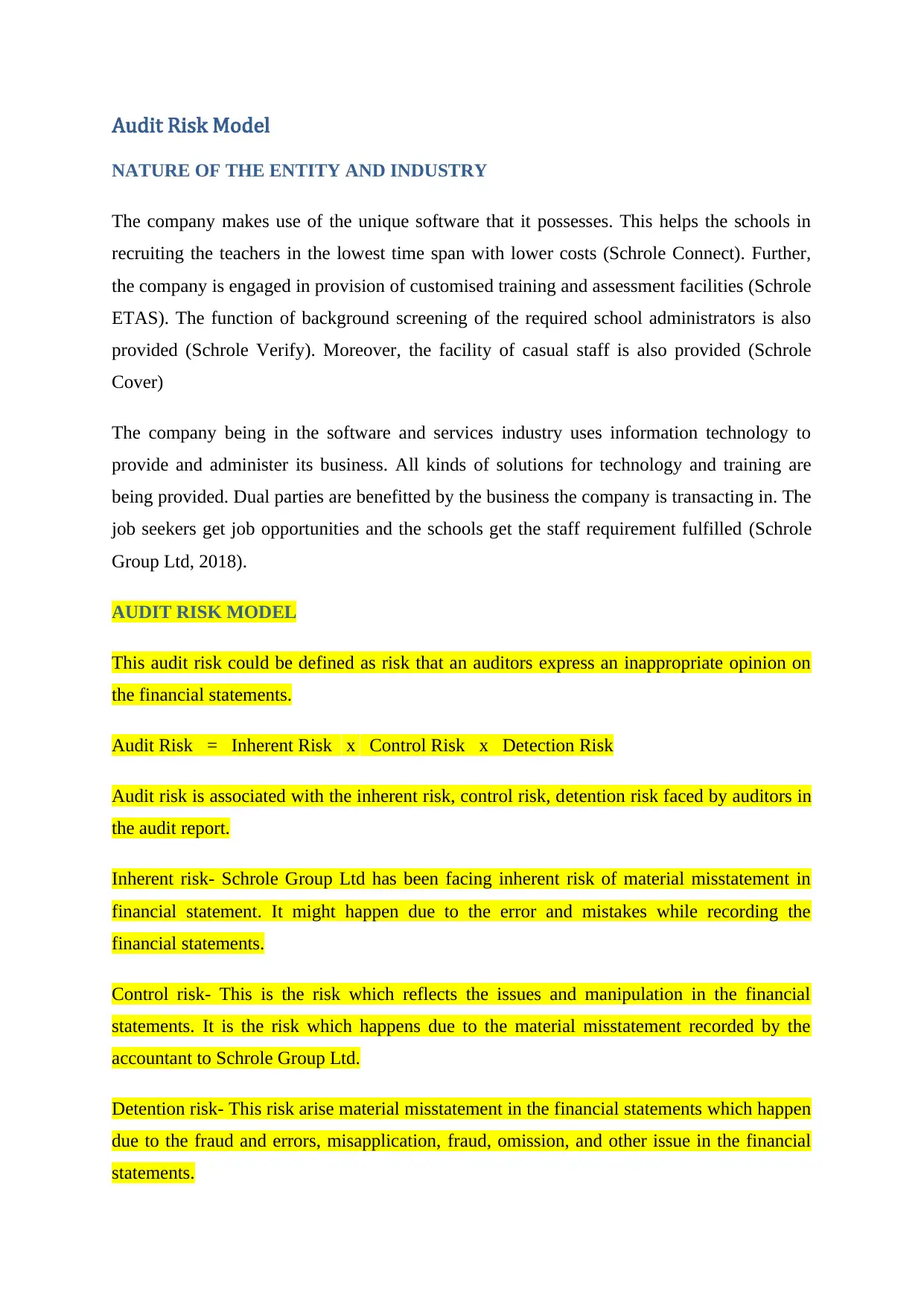
Audit Risk Model
NATURE OF THE ENTITY AND INDUSTRY
The company makes use of the unique software that it possesses. This helps the schools in
recruiting the teachers in the lowest time span with lower costs (Schrole Connect). Further,
the company is engaged in provision of customised training and assessment facilities (Schrole
ETAS). The function of background screening of the required school administrators is also
provided (Schrole Verify). Moreover, the facility of casual staff is also provided (Schrole
Cover)
The company being in the software and services industry uses information technology to
provide and administer its business. All kinds of solutions for technology and training are
being provided. Dual parties are benefitted by the business the company is transacting in. The
job seekers get job opportunities and the schools get the staff requirement fulfilled (Schrole
Group Ltd, 2018).
AUDIT RISK MODEL
This audit risk could be defined as risk that an auditors express an inappropriate opinion on
the financial statements.
Audit Risk = Inherent Risk x Control Risk x Detection Risk
Audit risk is associated with the inherent risk, control risk, detention risk faced by auditors in
the audit report.
Inherent risk- Schrole Group Ltd has been facing inherent risk of material misstatement in
financial statement. It might happen due to the error and mistakes while recording the
financial statements.
Control risk- This is the risk which reflects the issues and manipulation in the financial
statements. It is the risk which happens due to the material misstatement recorded by the
accountant to Schrole Group Ltd.
Detention risk- This risk arise material misstatement in the financial statements which happen
due to the fraud and errors, misapplication, fraud, omission, and other issue in the financial
statements.
NATURE OF THE ENTITY AND INDUSTRY
The company makes use of the unique software that it possesses. This helps the schools in
recruiting the teachers in the lowest time span with lower costs (Schrole Connect). Further,
the company is engaged in provision of customised training and assessment facilities (Schrole
ETAS). The function of background screening of the required school administrators is also
provided (Schrole Verify). Moreover, the facility of casual staff is also provided (Schrole
Cover)
The company being in the software and services industry uses information technology to
provide and administer its business. All kinds of solutions for technology and training are
being provided. Dual parties are benefitted by the business the company is transacting in. The
job seekers get job opportunities and the schools get the staff requirement fulfilled (Schrole
Group Ltd, 2018).
AUDIT RISK MODEL
This audit risk could be defined as risk that an auditors express an inappropriate opinion on
the financial statements.
Audit Risk = Inherent Risk x Control Risk x Detection Risk
Audit risk is associated with the inherent risk, control risk, detention risk faced by auditors in
the audit report.
Inherent risk- Schrole Group Ltd has been facing inherent risk of material misstatement in
financial statement. It might happen due to the error and mistakes while recording the
financial statements.
Control risk- This is the risk which reflects the issues and manipulation in the financial
statements. It is the risk which happens due to the material misstatement recorded by the
accountant to Schrole Group Ltd.
Detention risk- This risk arise material misstatement in the financial statements which happen
due to the fraud and errors, misapplication, fraud, omission, and other issue in the financial
statements.
Paraphrase This Document
Need a fresh take? Get an instant paraphrase of this document with our AI Paraphraser
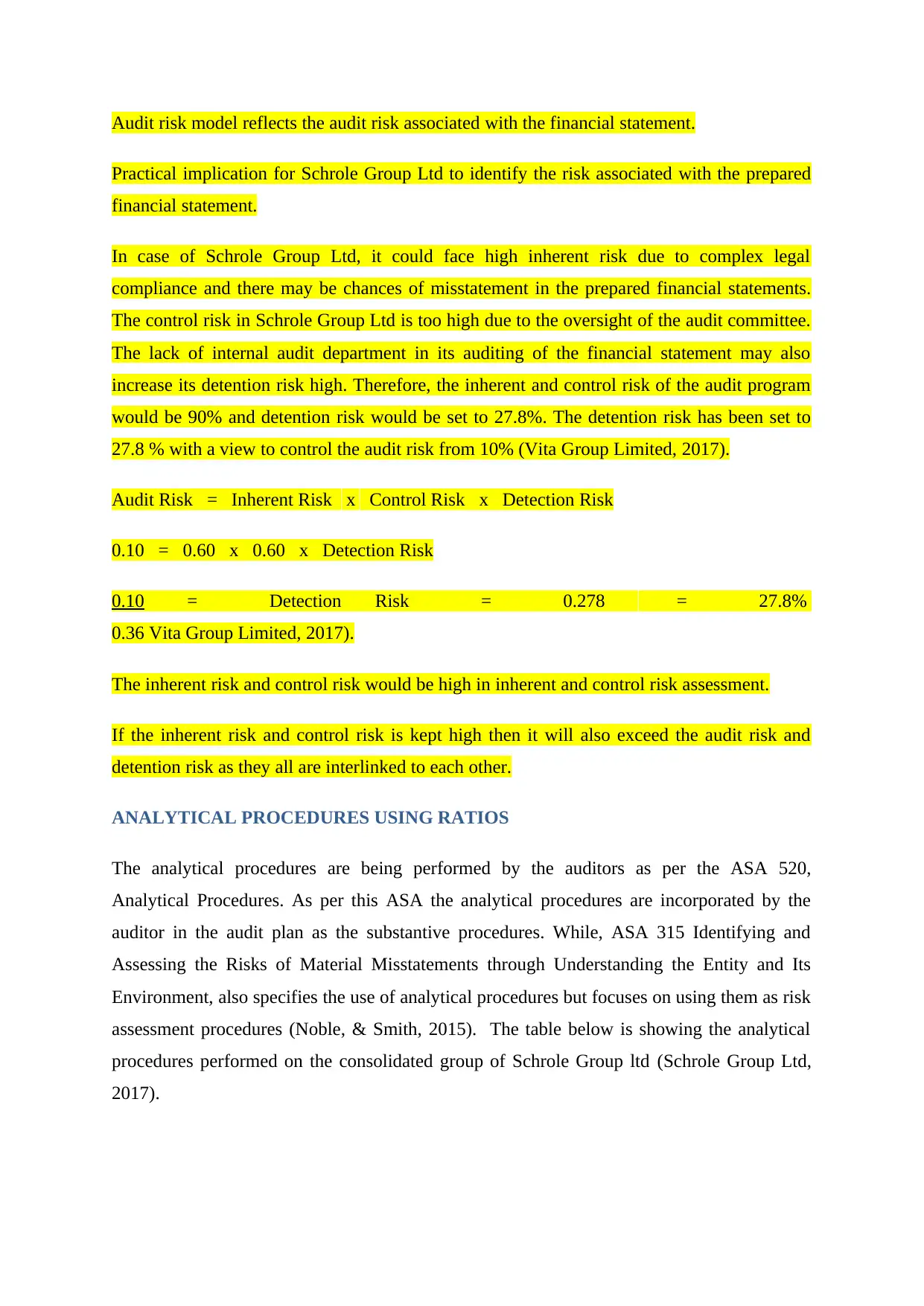
Audit risk model reflects the audit risk associated with the financial statement.
Practical implication for Schrole Group Ltd to identify the risk associated with the prepared
financial statement.
In case of Schrole Group Ltd, it could face high inherent risk due to complex legal
compliance and there may be chances of misstatement in the prepared financial statements.
The control risk in Schrole Group Ltd is too high due to the oversight of the audit committee.
The lack of internal audit department in its auditing of the financial statement may also
increase its detention risk high. Therefore, the inherent and control risk of the audit program
would be 90% and detention risk would be set to 27.8%. The detention risk has been set to
27.8 % with a view to control the audit risk from 10% (Vita Group Limited, 2017).
Audit Risk = Inherent Risk x Control Risk x Detection Risk
0.10 = 0.60 x 0.60 x Detection Risk
0.10 = Detection Risk = 0.278 = 27.8%
0.36 Vita Group Limited, 2017).
The inherent risk and control risk would be high in inherent and control risk assessment.
If the inherent risk and control risk is kept high then it will also exceed the audit risk and
detention risk as they all are interlinked to each other.
ANALYTICAL PROCEDURES USING RATIOS
The analytical procedures are being performed by the auditors as per the ASA 520,
Analytical Procedures. As per this ASA the analytical procedures are incorporated by the
auditor in the audit plan as the substantive procedures. While, ASA 315 Identifying and
Assessing the Risks of Material Misstatements through Understanding the Entity and Its
Environment, also specifies the use of analytical procedures but focuses on using them as risk
assessment procedures (Noble, & Smith, 2015). The table below is showing the analytical
procedures performed on the consolidated group of Schrole Group ltd (Schrole Group Ltd,
2017).
Practical implication for Schrole Group Ltd to identify the risk associated with the prepared
financial statement.
In case of Schrole Group Ltd, it could face high inherent risk due to complex legal
compliance and there may be chances of misstatement in the prepared financial statements.
The control risk in Schrole Group Ltd is too high due to the oversight of the audit committee.
The lack of internal audit department in its auditing of the financial statement may also
increase its detention risk high. Therefore, the inherent and control risk of the audit program
would be 90% and detention risk would be set to 27.8%. The detention risk has been set to
27.8 % with a view to control the audit risk from 10% (Vita Group Limited, 2017).
Audit Risk = Inherent Risk x Control Risk x Detection Risk
0.10 = 0.60 x 0.60 x Detection Risk
0.10 = Detection Risk = 0.278 = 27.8%
0.36 Vita Group Limited, 2017).
The inherent risk and control risk would be high in inherent and control risk assessment.
If the inherent risk and control risk is kept high then it will also exceed the audit risk and
detention risk as they all are interlinked to each other.
ANALYTICAL PROCEDURES USING RATIOS
The analytical procedures are being performed by the auditors as per the ASA 520,
Analytical Procedures. As per this ASA the analytical procedures are incorporated by the
auditor in the audit plan as the substantive procedures. While, ASA 315 Identifying and
Assessing the Risks of Material Misstatements through Understanding the Entity and Its
Environment, also specifies the use of analytical procedures but focuses on using them as risk
assessment procedures (Noble, & Smith, 2015). The table below is showing the analytical
procedures performed on the consolidated group of Schrole Group ltd (Schrole Group Ltd,
2017).
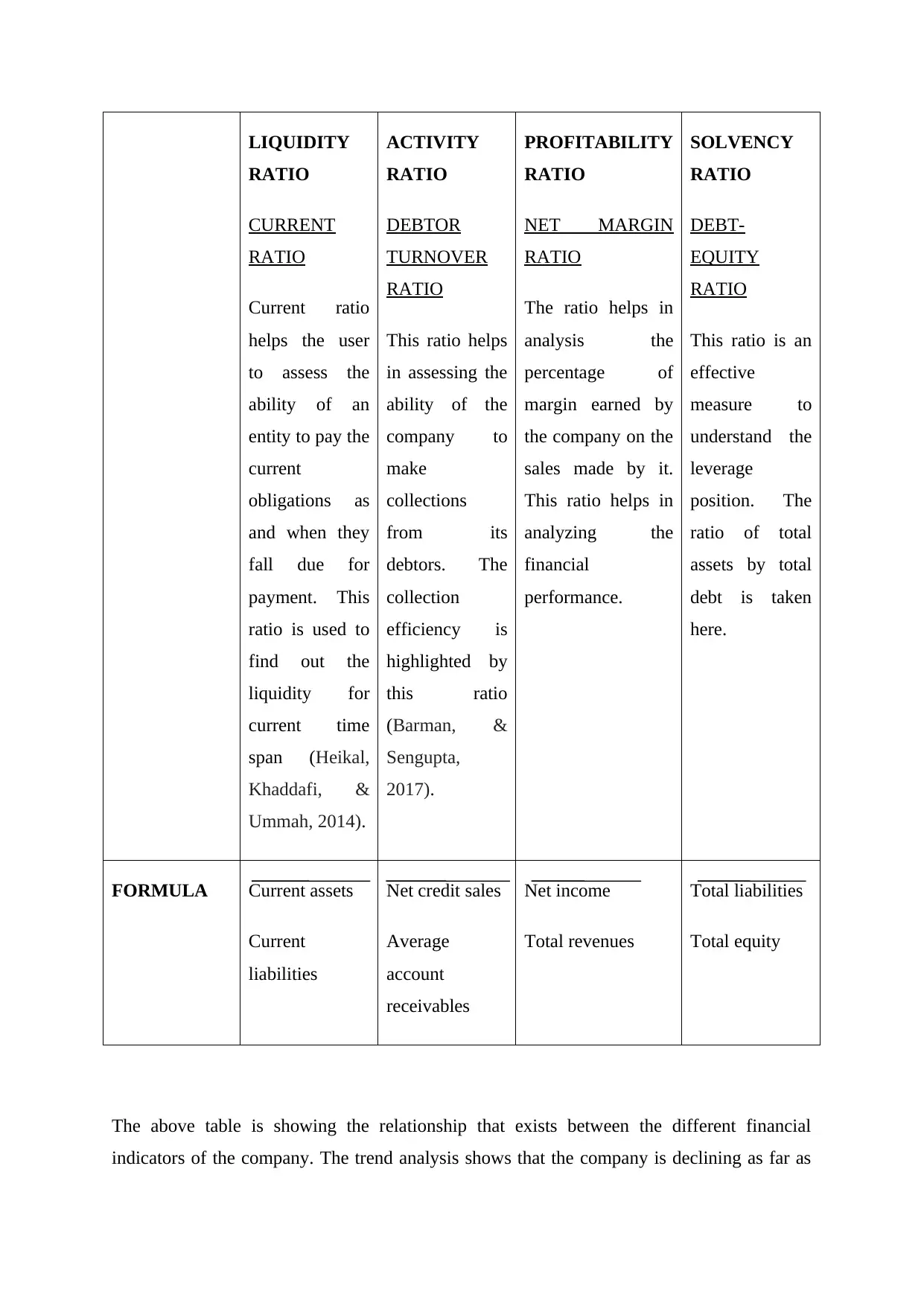
LIQUIDITY
RATIO
CURRENT
RATIO
Current ratio
helps the user
to assess the
ability of an
entity to pay the
current
obligations as
and when they
fall due for
payment. This
ratio is used to
find out the
liquidity for
current time
span (Heikal,
Khaddafi, &
Ummah, 2014).
ACTIVITY
RATIO
DEBTOR
TURNOVER
RATIO
This ratio helps
in assessing the
ability of the
company to
make
collections
from its
debtors. The
collection
efficiency is
highlighted by
this ratio
(Barman, &
Sengupta,
2017).
PROFITABILITY
RATIO
NET MARGIN
RATIO
The ratio helps in
analysis the
percentage of
margin earned by
the company on the
sales made by it.
This ratio helps in
analyzing the
financial
performance.
SOLVENCY
RATIO
DEBT-
EQUITY
RATIO
This ratio is an
effective
measure to
understand the
leverage
position. The
ratio of total
assets by total
debt is taken
here.
FORMULA Current assets
Current
liabilities
Net credit sales
Average
account
receivables
Net income
Total revenues
Total liabilities
Total equity
The above table is showing the relationship that exists between the different financial
indicators of the company. The trend analysis shows that the company is declining as far as
RATIO
CURRENT
RATIO
Current ratio
helps the user
to assess the
ability of an
entity to pay the
current
obligations as
and when they
fall due for
payment. This
ratio is used to
find out the
liquidity for
current time
span (Heikal,
Khaddafi, &
Ummah, 2014).
ACTIVITY
RATIO
DEBTOR
TURNOVER
RATIO
This ratio helps
in assessing the
ability of the
company to
make
collections
from its
debtors. The
collection
efficiency is
highlighted by
this ratio
(Barman, &
Sengupta,
2017).
PROFITABILITY
RATIO
NET MARGIN
RATIO
The ratio helps in
analysis the
percentage of
margin earned by
the company on the
sales made by it.
This ratio helps in
analyzing the
financial
performance.
SOLVENCY
RATIO
DEBT-
EQUITY
RATIO
This ratio is an
effective
measure to
understand the
leverage
position. The
ratio of total
assets by total
debt is taken
here.
FORMULA Current assets
Current
liabilities
Net credit sales
Average
account
receivables
Net income
Total revenues
Total liabilities
Total equity
The above table is showing the relationship that exists between the different financial
indicators of the company. The trend analysis shows that the company is declining as far as
⊘ This is a preview!⊘
Do you want full access?
Subscribe today to unlock all pages.

Trusted by 1+ million students worldwide
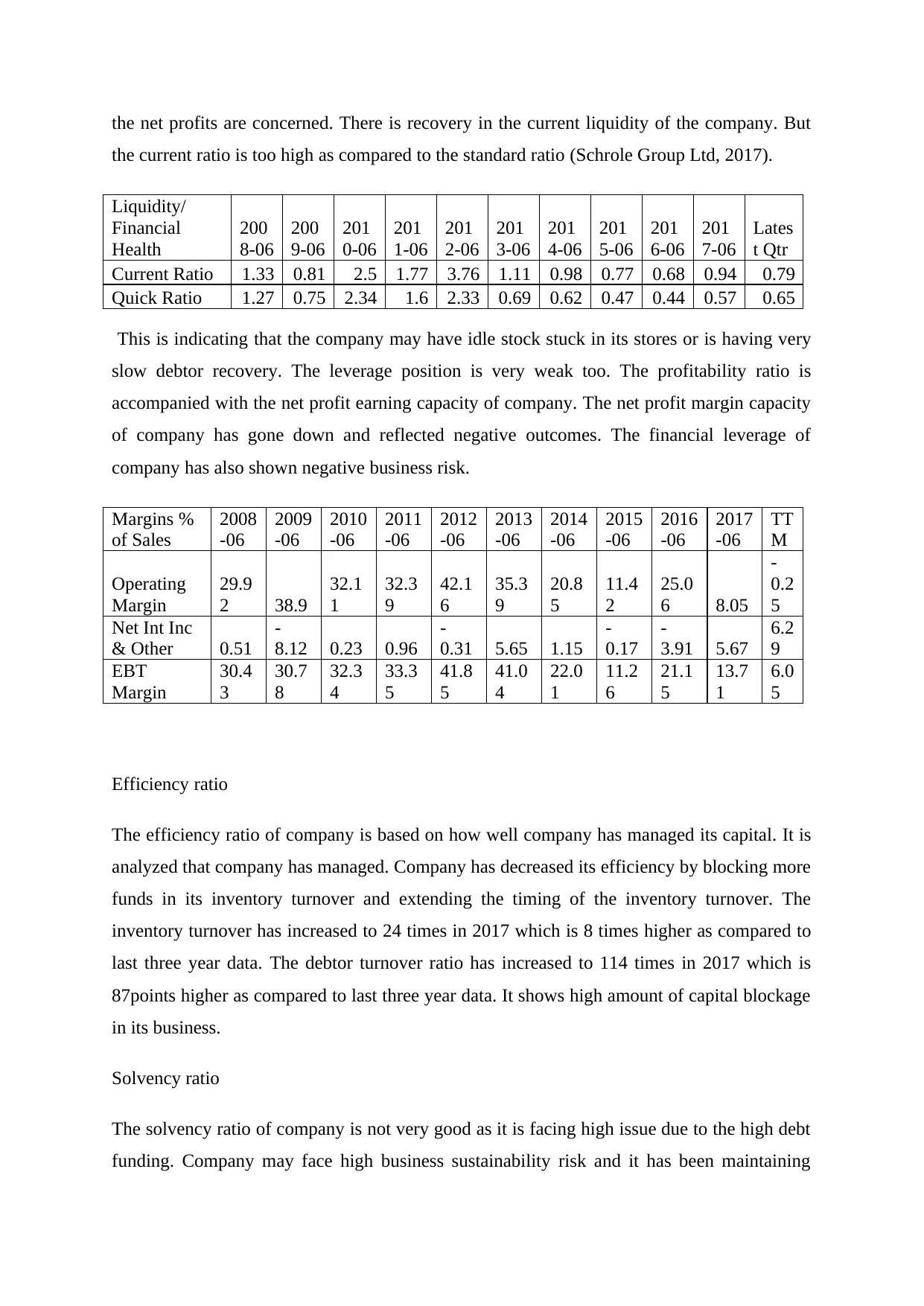
the net profits are concerned. There is recovery in the current liquidity of the company. But
the current ratio is too high as compared to the standard ratio (Schrole Group Ltd, 2017).
Liquidity/
Financial
Health
200
8-06
200
9-06
201
0-06
201
1-06
201
2-06
201
3-06
201
4-06
201
5-06
201
6-06
201
7-06
Lates
t Qtr
Current Ratio 1.33 0.81 2.5 1.77 3.76 1.11 0.98 0.77 0.68 0.94 0.79
Quick Ratio 1.27 0.75 2.34 1.6 2.33 0.69 0.62 0.47 0.44 0.57 0.65
This is indicating that the company may have idle stock stuck in its stores or is having very
slow debtor recovery. The leverage position is very weak too. The profitability ratio is
accompanied with the net profit earning capacity of company. The net profit margin capacity
of company has gone down and reflected negative outcomes. The financial leverage of
company has also shown negative business risk.
Margins %
of Sales
2008
-06
2009
-06
2010
-06
2011
-06
2012
-06
2013
-06
2014
-06
2015
-06
2016
-06
2017
-06
TT
M
Operating
Margin
29.9
2 38.9
32.1
1
32.3
9
42.1
6
35.3
9
20.8
5
11.4
2
25.0
6 8.05
-
0.2
5
Net Int Inc
& Other 0.51
-
8.12 0.23 0.96
-
0.31 5.65 1.15
-
0.17
-
3.91 5.67
6.2
9
EBT
Margin
30.4
3
30.7
8
32.3
4
33.3
5
41.8
5
41.0
4
22.0
1
11.2
6
21.1
5
13.7
1
6.0
5
Efficiency ratio
The efficiency ratio of company is based on how well company has managed its capital. It is
analyzed that company has managed. Company has decreased its efficiency by blocking more
funds in its inventory turnover and extending the timing of the inventory turnover. The
inventory turnover has increased to 24 times in 2017 which is 8 times higher as compared to
last three year data. The debtor turnover ratio has increased to 114 times in 2017 which is
87points higher as compared to last three year data. It shows high amount of capital blockage
in its business.
Solvency ratio
The solvency ratio of company is not very good as it is facing high issue due to the high debt
funding. Company may face high business sustainability risk and it has been maintaining
the current ratio is too high as compared to the standard ratio (Schrole Group Ltd, 2017).
Liquidity/
Financial
Health
200
8-06
200
9-06
201
0-06
201
1-06
201
2-06
201
3-06
201
4-06
201
5-06
201
6-06
201
7-06
Lates
t Qtr
Current Ratio 1.33 0.81 2.5 1.77 3.76 1.11 0.98 0.77 0.68 0.94 0.79
Quick Ratio 1.27 0.75 2.34 1.6 2.33 0.69 0.62 0.47 0.44 0.57 0.65
This is indicating that the company may have idle stock stuck in its stores or is having very
slow debtor recovery. The leverage position is very weak too. The profitability ratio is
accompanied with the net profit earning capacity of company. The net profit margin capacity
of company has gone down and reflected negative outcomes. The financial leverage of
company has also shown negative business risk.
Margins %
of Sales
2008
-06
2009
-06
2010
-06
2011
-06
2012
-06
2013
-06
2014
-06
2015
-06
2016
-06
2017
-06
TT
M
Operating
Margin
29.9
2 38.9
32.1
1
32.3
9
42.1
6
35.3
9
20.8
5
11.4
2
25.0
6 8.05
-
0.2
5
Net Int Inc
& Other 0.51
-
8.12 0.23 0.96
-
0.31 5.65 1.15
-
0.17
-
3.91 5.67
6.2
9
EBT
Margin
30.4
3
30.7
8
32.3
4
33.3
5
41.8
5
41.0
4
22.0
1
11.2
6
21.1
5
13.7
1
6.0
5
Efficiency ratio
The efficiency ratio of company is based on how well company has managed its capital. It is
analyzed that company has managed. Company has decreased its efficiency by blocking more
funds in its inventory turnover and extending the timing of the inventory turnover. The
inventory turnover has increased to 24 times in 2017 which is 8 times higher as compared to
last three year data. The debtor turnover ratio has increased to 114 times in 2017 which is
87points higher as compared to last three year data. It shows high amount of capital blockage
in its business.
Solvency ratio
The solvency ratio of company is not very good as it is facing high issue due to the high debt
funding. Company may face high business sustainability risk and it has been maintaining
Paraphrase This Document
Need a fresh take? Get an instant paraphrase of this document with our AI Paraphraser
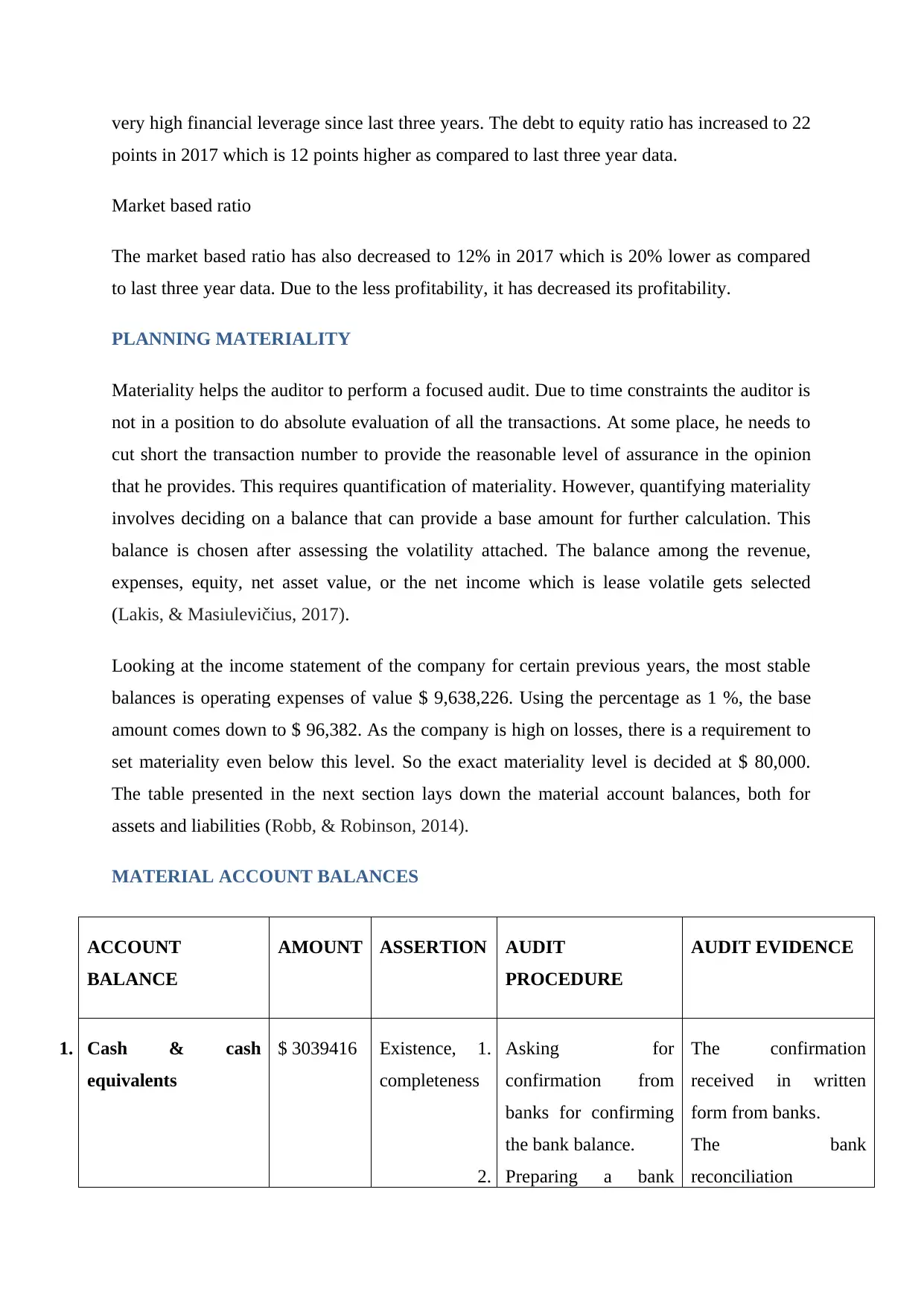
very high financial leverage since last three years. The debt to equity ratio has increased to 22
points in 2017 which is 12 points higher as compared to last three year data.
Market based ratio
The market based ratio has also decreased to 12% in 2017 which is 20% lower as compared
to last three year data. Due to the less profitability, it has decreased its profitability.
PLANNING MATERIALITY
Materiality helps the auditor to perform a focused audit. Due to time constraints the auditor is
not in a position to do absolute evaluation of all the transactions. At some place, he needs to
cut short the transaction number to provide the reasonable level of assurance in the opinion
that he provides. This requires quantification of materiality. However, quantifying materiality
involves deciding on a balance that can provide a base amount for further calculation. This
balance is chosen after assessing the volatility attached. The balance among the revenue,
expenses, equity, net asset value, or the net income which is lease volatile gets selected
(Lakis, & Masiulevičius, 2017).
Looking at the income statement of the company for certain previous years, the most stable
balances is operating expenses of value $ 9,638,226. Using the percentage as 1 %, the base
amount comes down to $ 96,382. As the company is high on losses, there is a requirement to
set materiality even below this level. So the exact materiality level is decided at $ 80,000.
The table presented in the next section lays down the material account balances, both for
assets and liabilities (Robb, & Robinson, 2014).
MATERIAL ACCOUNT BALANCES
ACCOUNT
BALANCE
AMOUNT ASSERTION AUDIT
PROCEDURE
AUDIT EVIDENCE
1. Cash & cash
equivalents
$ 3039416 Existence,
completeness
1. Asking for
confirmation from
banks for confirming
the bank balance.
2. Preparing a bank
The confirmation
received in written
form from banks.
The bank
reconciliation
points in 2017 which is 12 points higher as compared to last three year data.
Market based ratio
The market based ratio has also decreased to 12% in 2017 which is 20% lower as compared
to last three year data. Due to the less profitability, it has decreased its profitability.
PLANNING MATERIALITY
Materiality helps the auditor to perform a focused audit. Due to time constraints the auditor is
not in a position to do absolute evaluation of all the transactions. At some place, he needs to
cut short the transaction number to provide the reasonable level of assurance in the opinion
that he provides. This requires quantification of materiality. However, quantifying materiality
involves deciding on a balance that can provide a base amount for further calculation. This
balance is chosen after assessing the volatility attached. The balance among the revenue,
expenses, equity, net asset value, or the net income which is lease volatile gets selected
(Lakis, & Masiulevičius, 2017).
Looking at the income statement of the company for certain previous years, the most stable
balances is operating expenses of value $ 9,638,226. Using the percentage as 1 %, the base
amount comes down to $ 96,382. As the company is high on losses, there is a requirement to
set materiality even below this level. So the exact materiality level is decided at $ 80,000.
The table presented in the next section lays down the material account balances, both for
assets and liabilities (Robb, & Robinson, 2014).
MATERIAL ACCOUNT BALANCES
ACCOUNT
BALANCE
AMOUNT ASSERTION AUDIT
PROCEDURE
AUDIT EVIDENCE
1. Cash & cash
equivalents
$ 3039416 Existence,
completeness
1. Asking for
confirmation from
banks for confirming
the bank balance.
2. Preparing a bank
The confirmation
received in written
form from banks.
The bank
reconciliation
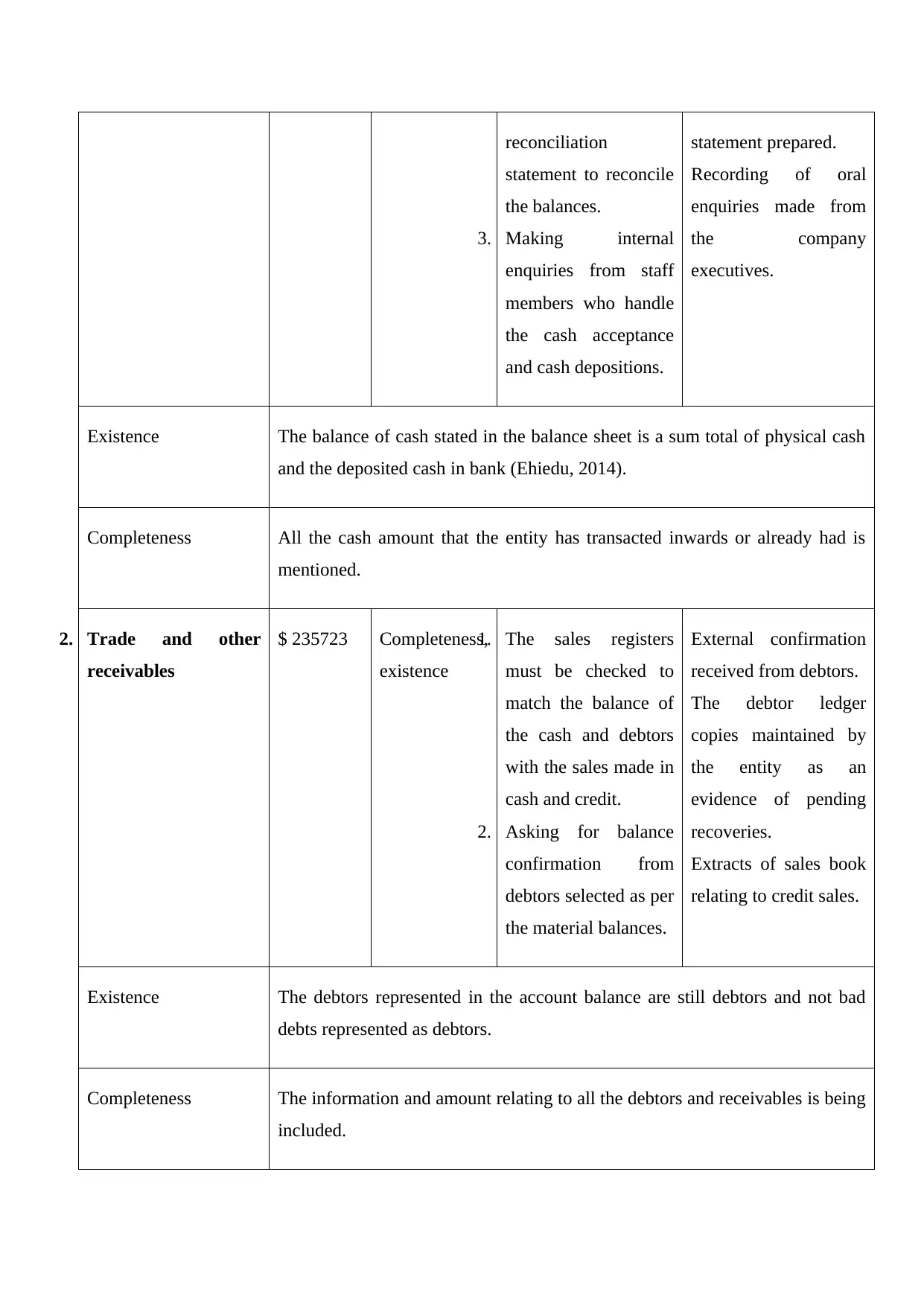
reconciliation
statement to reconcile
the balances.
3. Making internal
enquiries from staff
members who handle
the cash acceptance
and cash depositions.
statement prepared.
Recording of oral
enquiries made from
the company
executives.
Existence The balance of cash stated in the balance sheet is a sum total of physical cash
and the deposited cash in bank (Ehiedu, 2014).
Completeness All the cash amount that the entity has transacted inwards or already had is
mentioned.
2. Trade and other
receivables
$ 235723 Completeness,
existence
1. The sales registers
must be checked to
match the balance of
the cash and debtors
with the sales made in
cash and credit.
2. Asking for balance
confirmation from
debtors selected as per
the material balances.
External confirmation
received from debtors.
The debtor ledger
copies maintained by
the entity as an
evidence of pending
recoveries.
Extracts of sales book
relating to credit sales.
Existence The debtors represented in the account balance are still debtors and not bad
debts represented as debtors.
Completeness The information and amount relating to all the debtors and receivables is being
included.
statement to reconcile
the balances.
3. Making internal
enquiries from staff
members who handle
the cash acceptance
and cash depositions.
statement prepared.
Recording of oral
enquiries made from
the company
executives.
Existence The balance of cash stated in the balance sheet is a sum total of physical cash
and the deposited cash in bank (Ehiedu, 2014).
Completeness All the cash amount that the entity has transacted inwards or already had is
mentioned.
2. Trade and other
receivables
$ 235723 Completeness,
existence
1. The sales registers
must be checked to
match the balance of
the cash and debtors
with the sales made in
cash and credit.
2. Asking for balance
confirmation from
debtors selected as per
the material balances.
External confirmation
received from debtors.
The debtor ledger
copies maintained by
the entity as an
evidence of pending
recoveries.
Extracts of sales book
relating to credit sales.
Existence The debtors represented in the account balance are still debtors and not bad
debts represented as debtors.
Completeness The information and amount relating to all the debtors and receivables is being
included.
⊘ This is a preview!⊘
Do you want full access?
Subscribe today to unlock all pages.

Trusted by 1+ million students worldwide
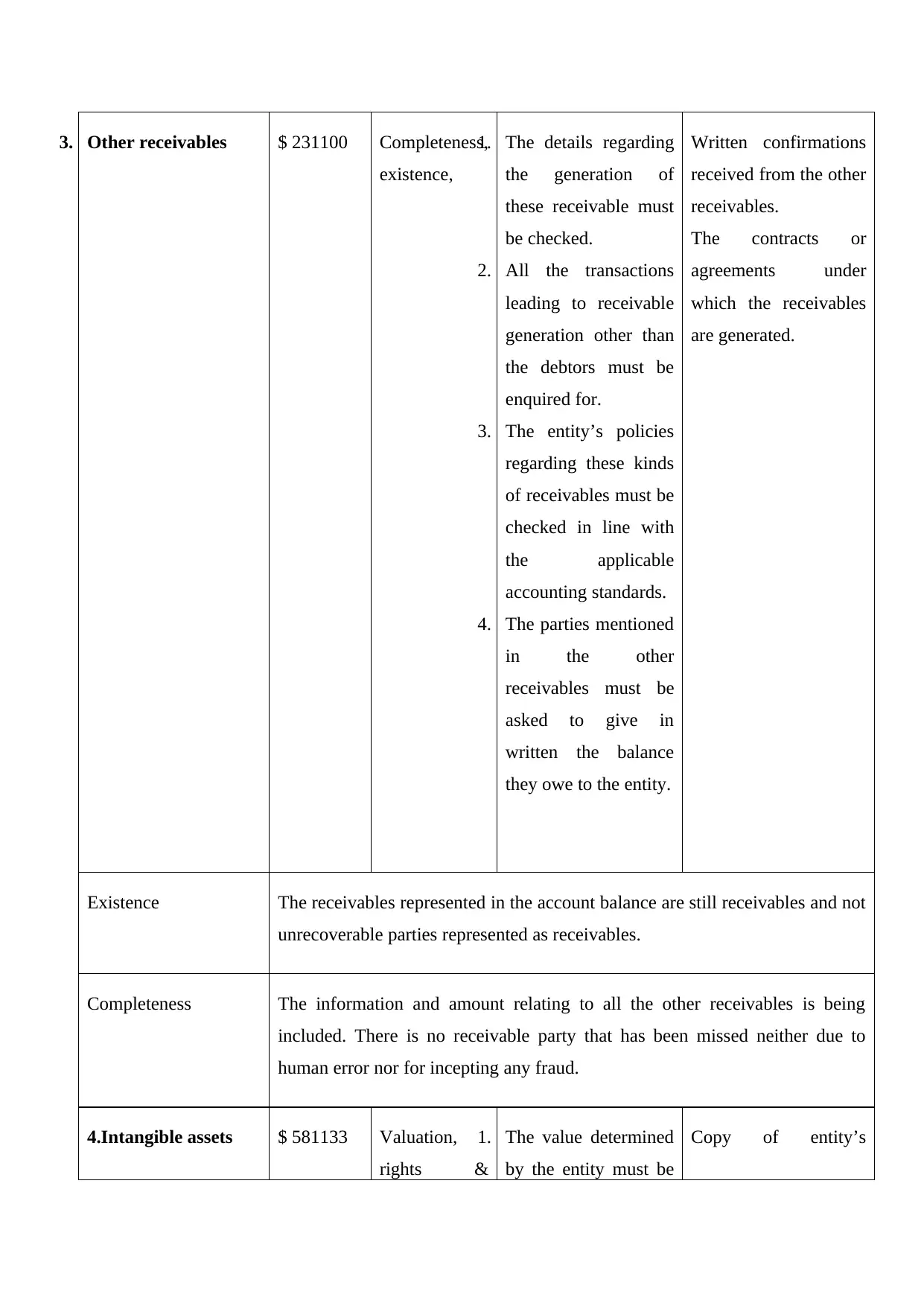
3. Other receivables $ 231100 Completeness,
existence,
1. The details regarding
the generation of
these receivable must
be checked.
2. All the transactions
leading to receivable
generation other than
the debtors must be
enquired for.
3. The entity’s policies
regarding these kinds
of receivables must be
checked in line with
the applicable
accounting standards.
4. The parties mentioned
in the other
receivables must be
asked to give in
written the balance
they owe to the entity.
Written confirmations
received from the other
receivables.
The contracts or
agreements under
which the receivables
are generated.
Existence The receivables represented in the account balance are still receivables and not
unrecoverable parties represented as receivables.
Completeness The information and amount relating to all the other receivables is being
included. There is no receivable party that has been missed neither due to
human error nor for incepting any fraud.
4.Intangible assets $ 581133 Valuation,
rights &
1. The value determined
by the entity must be
Copy of entity’s
existence,
1. The details regarding
the generation of
these receivable must
be checked.
2. All the transactions
leading to receivable
generation other than
the debtors must be
enquired for.
3. The entity’s policies
regarding these kinds
of receivables must be
checked in line with
the applicable
accounting standards.
4. The parties mentioned
in the other
receivables must be
asked to give in
written the balance
they owe to the entity.
Written confirmations
received from the other
receivables.
The contracts or
agreements under
which the receivables
are generated.
Existence The receivables represented in the account balance are still receivables and not
unrecoverable parties represented as receivables.
Completeness The information and amount relating to all the other receivables is being
included. There is no receivable party that has been missed neither due to
human error nor for incepting any fraud.
4.Intangible assets $ 581133 Valuation,
rights &
1. The value determined
by the entity must be
Copy of entity’s
Paraphrase This Document
Need a fresh take? Get an instant paraphrase of this document with our AI Paraphraser
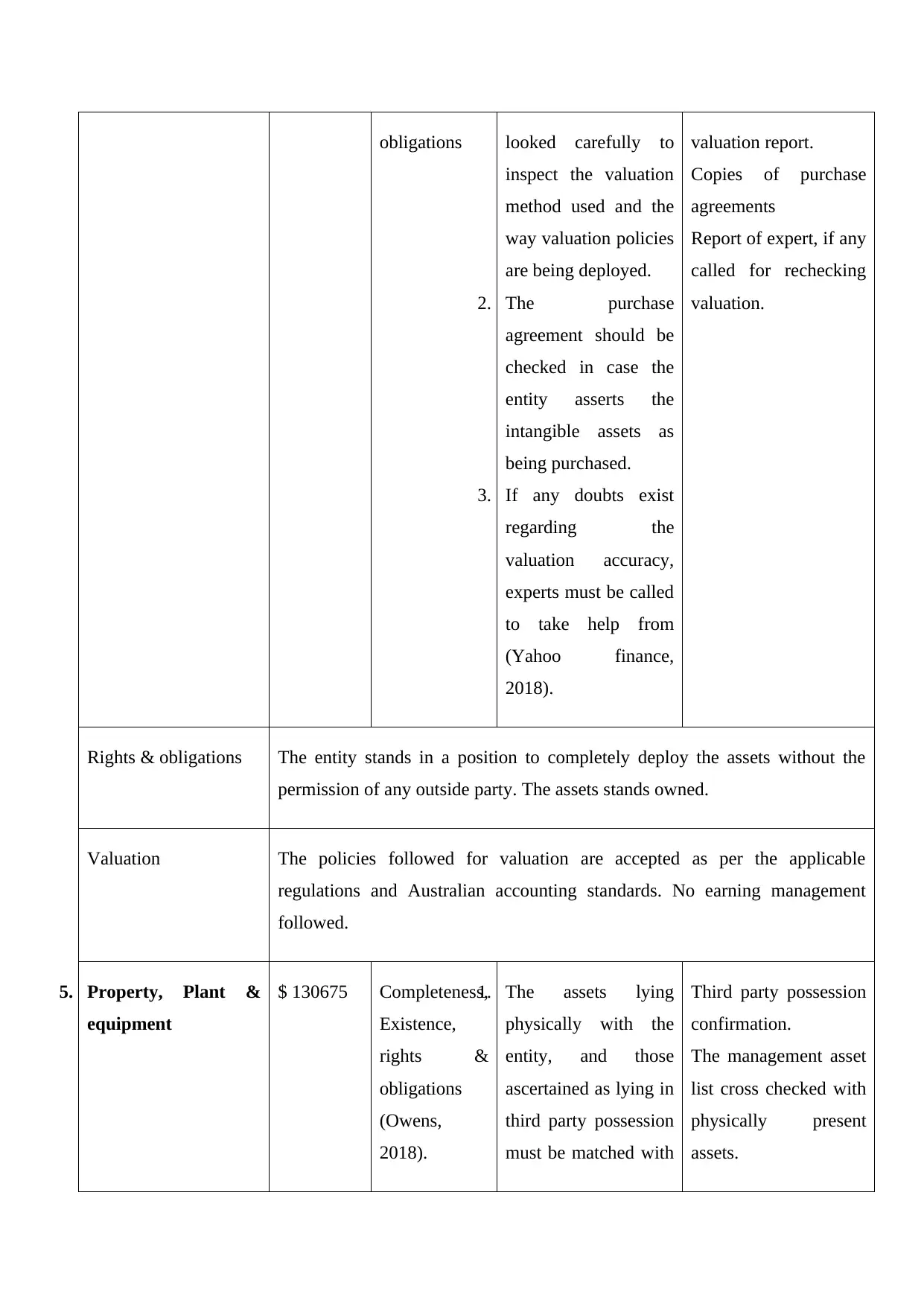
obligations looked carefully to
inspect the valuation
method used and the
way valuation policies
are being deployed.
2. The purchase
agreement should be
checked in case the
entity asserts the
intangible assets as
being purchased.
3. If any doubts exist
regarding the
valuation accuracy,
experts must be called
to take help from
(Yahoo finance,
2018).
valuation report.
Copies of purchase
agreements
Report of expert, if any
called for rechecking
valuation.
Rights & obligations The entity stands in a position to completely deploy the assets without the
permission of any outside party. The assets stands owned.
Valuation The policies followed for valuation are accepted as per the applicable
regulations and Australian accounting standards. No earning management
followed.
5. Property, Plant &
equipment
$ 130675 Completeness,
Existence,
rights &
obligations
(Owens,
2018).
1. The assets lying
physically with the
entity, and those
ascertained as lying in
third party possession
must be matched with
Third party possession
confirmation.
The management asset
list cross checked with
physically present
assets.
inspect the valuation
method used and the
way valuation policies
are being deployed.
2. The purchase
agreement should be
checked in case the
entity asserts the
intangible assets as
being purchased.
3. If any doubts exist
regarding the
valuation accuracy,
experts must be called
to take help from
(Yahoo finance,
2018).
valuation report.
Copies of purchase
agreements
Report of expert, if any
called for rechecking
valuation.
Rights & obligations The entity stands in a position to completely deploy the assets without the
permission of any outside party. The assets stands owned.
Valuation The policies followed for valuation are accepted as per the applicable
regulations and Australian accounting standards. No earning management
followed.
5. Property, Plant &
equipment
$ 130675 Completeness,
Existence,
rights &
obligations
(Owens,
2018).
1. The assets lying
physically with the
entity, and those
ascertained as lying in
third party possession
must be matched with
Third party possession
confirmation.
The management asset
list cross checked with
physically present
assets.
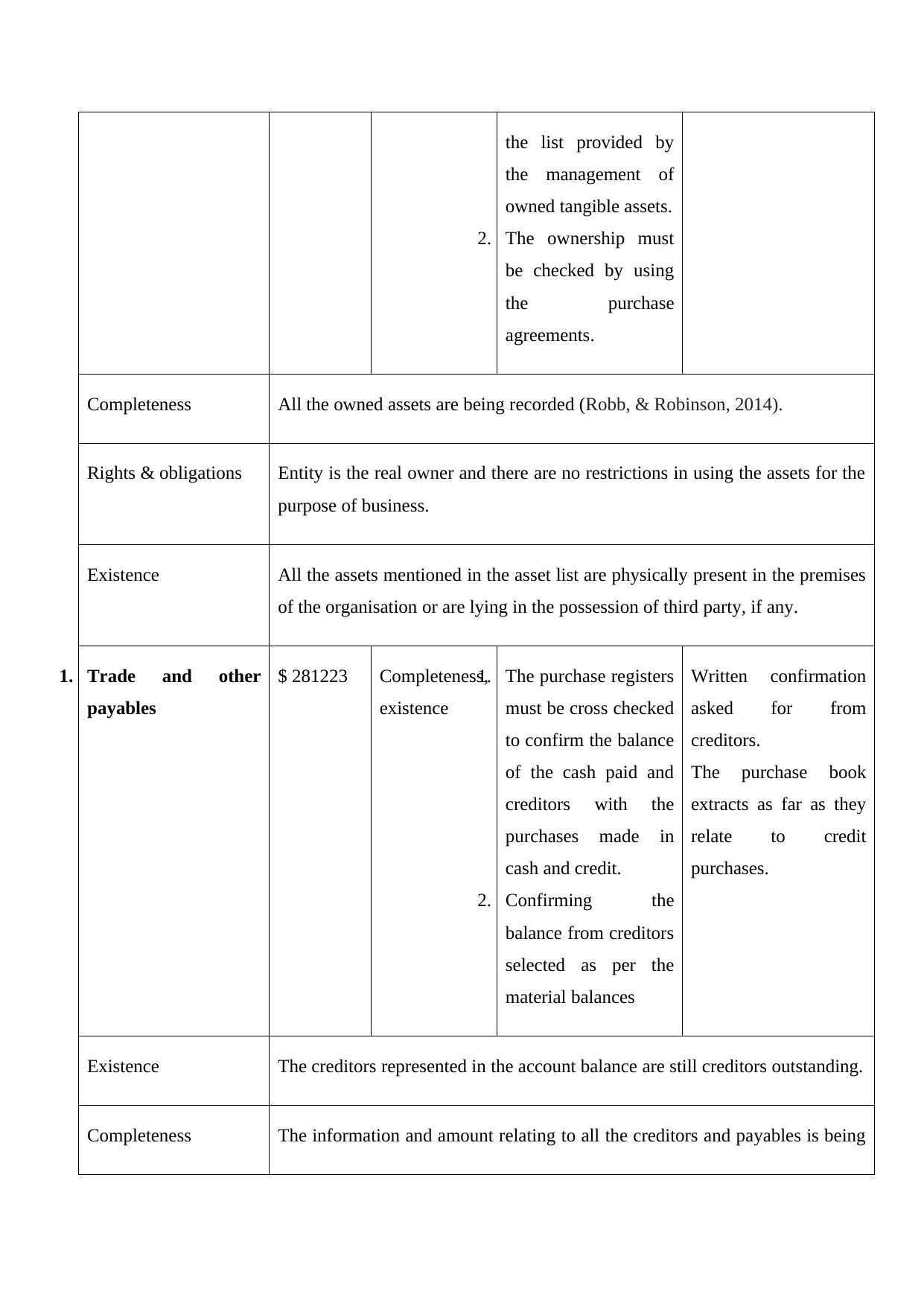
the list provided by
the management of
owned tangible assets.
2. The ownership must
be checked by using
the purchase
agreements.
Completeness All the owned assets are being recorded (Robb, & Robinson, 2014).
Rights & obligations Entity is the real owner and there are no restrictions in using the assets for the
purpose of business.
Existence All the assets mentioned in the asset list are physically present in the premises
of the organisation or are lying in the possession of third party, if any.
1. Trade and other
payables
$ 281223 Completeness,
existence
1. The purchase registers
must be cross checked
to confirm the balance
of the cash paid and
creditors with the
purchases made in
cash and credit.
2. Confirming the
balance from creditors
selected as per the
material balances
Written confirmation
asked for from
creditors.
The purchase book
extracts as far as they
relate to credit
purchases.
Existence The creditors represented in the account balance are still creditors outstanding.
Completeness The information and amount relating to all the creditors and payables is being
the management of
owned tangible assets.
2. The ownership must
be checked by using
the purchase
agreements.
Completeness All the owned assets are being recorded (Robb, & Robinson, 2014).
Rights & obligations Entity is the real owner and there are no restrictions in using the assets for the
purpose of business.
Existence All the assets mentioned in the asset list are physically present in the premises
of the organisation or are lying in the possession of third party, if any.
1. Trade and other
payables
$ 281223 Completeness,
existence
1. The purchase registers
must be cross checked
to confirm the balance
of the cash paid and
creditors with the
purchases made in
cash and credit.
2. Confirming the
balance from creditors
selected as per the
material balances
Written confirmation
asked for from
creditors.
The purchase book
extracts as far as they
relate to credit
purchases.
Existence The creditors represented in the account balance are still creditors outstanding.
Completeness The information and amount relating to all the creditors and payables is being
⊘ This is a preview!⊘
Do you want full access?
Subscribe today to unlock all pages.

Trusted by 1+ million students worldwide
1 out of 19
Related Documents
Your All-in-One AI-Powered Toolkit for Academic Success.
+13062052269
info@desklib.com
Available 24*7 on WhatsApp / Email
![[object Object]](/_next/static/media/star-bottom.7253800d.svg)
Unlock your academic potential
Copyright © 2020–2025 A2Z Services. All Rights Reserved. Developed and managed by ZUCOL.




